Yavana era
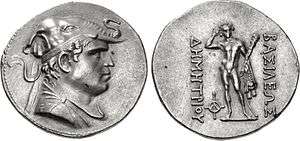
The Yavana Era, Yona Era or Yonana was a computational era used in the Indian subcontinent from the 2nd century BCE for several centuries thereafter.[1] It is thought that the era started around 186 BCE, and corresponds to accession to the Greco-Bactrian throne of Demetrius, who is said to have initiated the Indo-Greek conquest of parts of Northwestern South Asia.[1]
The creation of specific eras is a well-known phenomenon marking great dynastical events, such as the Seleucid era (starting in 312 BCE, with the return of Seleucus to Babylon), the Arsacid Era in Parthia (starting in 248/7), BCE), the Azes era in Gandhara (starting in 58/7), and the Kanishka era, when he established his empire in 127 CE.[1]
Coins of Plato
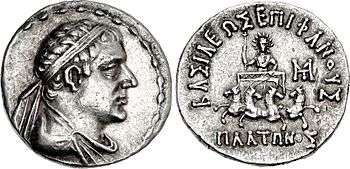
Obv: Diademed bust of Plato. Rev: Sun divinity Helios, riding a four-horse chariot. Greek legend: ΒΑΣΙΛΕΩΣ ΕΠΙΦΑΝΟΥΣ ΠΛΑΤΩΝΟΣ (BASILEOS EPIPHANOYS PLATONOS) "Of King Plato, Manifestation of God on earth". Coin marked MZ (bottom left of reverse), which possibly is a dating which equals year 47 Yavana era = 138 BCE.
Although Greco-Bactrian or Indo-Greek kings generally did not put dates on their coins, some of them Plato (circa 140 BCE) and Heliocles uncharacteristically do so. Some of the coins of Plato have inscriptions such as MZ, MT, MN which can be interpreted as dates in the Greek numerals system using the Yavana era which started around 186 BCE. In that case Plato ruled around 140 BCE. This matches the dating given by numismatician Bopearachchi, who places Plato between 145–140 BCE, since his coins are not found in the ruins of Ai Khanoum, a Bactrian city which was destroyed during the reign of Eucratides.[2]
Bajaur reliquary
A recently discovered reliquary (published by Salomon in 2005) from Bajaur gives a triple dating which allows to clarify the relationship between several eras: it is dated to the 27th regnal year of Vijayamitra, a king of the Indo-Scythian Apraca, the 73rd years of the Azes era, and the 201st year of the Greeks (Yonanas or Ionians).[1]
- "In the twenty-seventh - 27 - year in the reign of Lord Vijayamitra, the King of the Apraca; in the seventy-third - 73 - year which is called "of Azes", in the two hundred and first - 201 - year of the Yonas (Greeks), on the eighth day of the month of Sravana; on this day was established [this] stupa by Rukhana, the wife of the King of Apraca, [and] by Vijayamitra, the king of Apraca, [and] by Indravarma (Indravasu?), the commander (stratega), [together] with their wives and sons."[3]
The Azes era being generally dated to 57 BCE, this implies that the Yavana era started in 185 BCE. It also means that the Azes era started 128 years after the beginning of the Yavana era.
Yavanarajya inscription

The Yavanarajya inscription was discovered in Mathura, India in 1988. The inscription, carved on a block of red sandstone, is dated to the 1st century BCE, and is currently located at the Mathura Museum in Mathura.[4][5] The inscription is important in that the Mathura sculptors mention the date of their dedication as "The last day of year 116 of Yavana hegemony (Yavanarajya)". It is considered that this inscription is attesting the control of the Indo-Greeks in the 2nd and 1st centuries BCE in Mathura, a fact that is also confirmed by numismatic and literary evidence.[6]
Date referential of Buddha statues in Gandhara
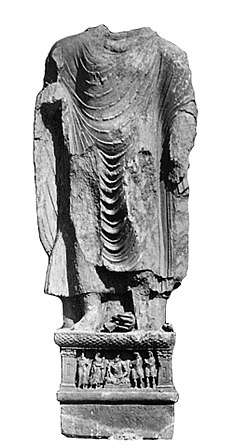
Several Gandhara Buddha statues with dated inscriptions, are now thought to have been dated in the Yavana Era. One of the statues of the Buddha from Loriyan Tangai has an inscription mentioning "the year 318". The era in question is not specified, but it is now thought, following the discovery of the Bajaur reliquary inscription, that it is about the Yavana era beginning in 186 BCE, and gives a date for the Buddha statue of about 143 CE.[7]
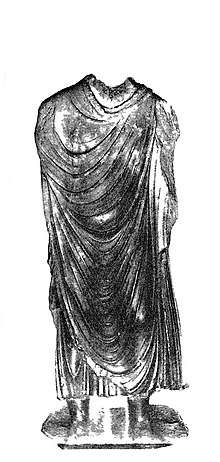
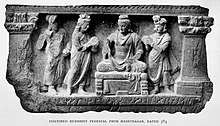
The inscription at the base of the statue is:
sa 1 1 1 100 10 4 4 Prothavadasa di 20 4 1 1 1 Budhagosa danamu(khe) Saghorumasa sadaviyasa
"In year 318, the day 27 of Prausthapada, gift of Buddhaghosa, the companion of Samghavarma"
— Inscription of the Buddha of Loriyan Tangai.[7]
This would make it one of the earliest known representations of the Buddha, after the Bimaran casket (1st century CE), and at about the same time as the Buddhist coins of Kanishka.[7]
The two devotees on the right side of the pedestal are in Indo-Scythian suit (loose trousers, tunic, and hood).[9] Their characteristic trousers appear clearly on close-up pictures. The statue is now in Indian Museum of Calcutta.[7]
Another statue of Buddha, the Buddha of Hashtnagar, is inscribed from the year 384, which is thought to be 209 CE. Only the pedestal is preserved in the British Museum, the statue itself, with folds of clothing having more relief than those of the Loriyan Tangai Buddha, having disappeared.[7]
References
- 1 2 3 4 Des Indo-Grecs aux Sassanides: données pour l'histoire et la géographie historique, Rika Gyselen, Peeters Publishers, 2007, p.103-109
- ↑ Publication by François Widemann in 2004 in "Une confirmation numismatique de l'ère Yavana de 186/185": "The author looks at the dated coinages of the Indo-Greek rulers Heliocles and Platon and argues that the dates are calculated according to a Yavana Era beginning in 186/5 BC." in Numismatic Literature, Numéro 149, American Numismatic Society, 2007
- ↑ "Afghanistan, carrefour en l'Est et l'Ouest" p.373. Also Senior 2003
- ↑ History of Early Stone Sculpture at Mathura: Ca. 150 BCE - 100 CE, Sonya Rhie Quintanilla, BRILL, 2007, p.254
- ↑ "Some Newly Discovered Inscriptions from Mathura : The Meghera Well Stone Inscription of Yavanarajya Year 160 Recently a stone inscription was acquired in the Government Museum, Mathura." India's ancient past, Shankar Goyal Book Enclave, 2004, p.189
- ↑ History of Early Stone Sculpture at Mathura: Ca. 150 BCE - 100 CE, Sonya Rhie Quintanilla, BRILL, 2007, p.8-10
- 1 2 3 4 5 6 Problems of Chronology in Gandharan Art, Juhyung Rhi, pp.35-51, 2017
- ↑ Problems of Chronology in Gandharan Art p.37
- ↑ Greco-Buddhist Art of Gandhara p.491